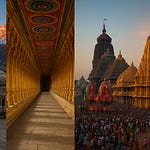Lord Parshuram: The Warrior Sage Born of Fire and Dharma
In the grand tapestry of Hindu mythology, few figures command as much intrigue and depth as Lord Parshuram. He’s a paradox in form—a Brahmin by birth but a warrior by destiny. Revered as the sixth avatar of Vishnu and one of the Chiranjeevis (immortals), Parshuram's story is one of divine purpose, unshakable dharma, and profound penance. But beyond the familiar tales, lies a wealth of lesser-known stories and insights that make his journey nothing short of legendary.
The Brahmin-Warrior: Born of Divine Irony
Parshuram’s origins are rooted in a curious twist of fate. His grandfather, Rishi Rucheeka, received two sacred potions from Lord Brahma (there is an alternate version that narrates that upon the request of his mother-in-law, Rishi Rucheek concocted two magical potions for his wife and mother-in-law to beget a son to both. He had concocted both potions with special sanskaras apt for a brahmin(for his wife) and a kshatriya(his mother-in-law))—one meant to birth a Brahmin, the other a Kshatriya. Due to a mix-up between Rucheeka’s wife and her mother, the Brahmin potion was consumed by the grandmother, and the Kshatriya potion by Rucheeka’s wife.
The grandmother gave birth to Renuka, a fierce, warrior-like woman.
Rucheeka’s wife bore Jamadagni, a tranquil, meditative sage.
Their union gave rise to Parshuram—a child born with a scholar’s mind and a warrior’s heart. A true embodiment of Brahma-Kshatriya fusion, he was destined to bridge the worlds of scripture and sword.
Disciple of Shiva, Wielder of the Divine Axe
Young Parshuram undertook intense penance to gain the blessings of Lord Shiva. In return, Shiva gifted him the mighty Parshu (axe) and trained him in the art of celestial warfare. Their relationship wasn't just devotional—it was dynamic.
Legend has it that Parshuram once engaged in a duel with Shiva, a cosmic test of strength that left even Mount Kailash trembling. Shiva, impressed by his disciple’s skill and humility, declared Parshuram his most fearsome student.
Another lesser-known tale recounts how Parshuram, in a fit of anger, severed Lord Ganesha’s tusk when denied entry to meet Shiva. Ganesha’s graceful acceptance of the injury turned the broken tusk into a timeless symbol of sacrifice.
A Son’s Fury: The War Against Adharma
Parshuram’s defining moment came when the arrogant King Kartavirya Arjuna murdered his father, Rishi Jamadagni, to seize the divine cow Kamadhenu. Grief-stricken and enraged, Parshuram vowed to rid the earth of corrupt Kshatriyas.
His vengeance was swift and devastating—he annihilated 21 generations of Kshatriyas, his axe soaked in their blood, creating the sacred Samanta Panchaka at Kurukshetra. But contrary to what some believe, Parshuram wasn’t anti-Kshatriya. He restored power to righteous kings after each purge. His war was against adharma, not monarchy.
Afterward, he donated the earth to the Brahmins and created Kerala by hurling his axe into the sea, reclaiming land that is still considered sacred today.
Guru of Great Warriors
Parshuram eventually shifted from warrior to teacher, mentoring some of the most iconic figures of Indian epics:
Bhishma, known for his vow and valor
Dronacharya, revered guru of the Pandavas and Kauravas
Karna, whom Parshuram mistakenly thought to be a Brahmin. Upon discovering the truth, he cursed Karna—forever altering the outcome of the Mahabharata
He even had brief spiritual interactions with Ravana, but parted ways due to conflicting ideologies.
The Avadhoota’s Blessing: Finding Divinity in Dattatreya
After years of bloodshed, Parshuram sought peace. Haunted by his past, he sought solace in the teachings of Dattatreya, the divine sage considered an incarnation of Brahma, Vishnu, and Shiva.
At first glance, Dattatreya’s ashram seemed anything but spiritual. He was surrounded by four dogs (symbolizing the Vedas), holding a wine jug (symbolizing divine nectar), and seated with a woman (Anagha Mata, representing cosmic energy). Yet Parshuram saw beyond appearances. He bowed and surrendered, recognizing Dattatreya as his true Guru.
Under Dattatreya’s guidance, Parshuram was initiated into the sacred knowledge of Tripura Rahasya, embracing the yogic path and finding inner transformation.
The Immortal Witness
Parshuram is among the seven immortals, the Chiranjeevis, who will live until the end of the current age. He resides in the Mahendra Mountains, in deep meditation, awaiting the arrival of the final avatar of Vishnu—Kalki.
It is said that Parshuram will emerge once more to hand over celestial weapons and divine wisdom to Kalki, helping restore dharma in a world lost to chaos.
Temples of Parshuram: Legacy Etched in Stone
Parshuram is worshipped across India, especially in regions like Konkan, Kerala, and Maharashtra. Here are some notable shrines:
Parshuram Temple, Chiplun (Maharashtra) – Houses his footprints and a shrine where he is worshipped as a Shivling.
Parshuram Kund, Arunachal Pradesh – A sacred site where he washed his axe after killing his mother.
Shri Kshetra Parshuram, Ratnagiri – Located on a mountain slope.
Parshuram Temple, Somnath (Gujarat) – Dedicated to his penance and encounter with Shiva.
Parshuram Temple, Pajaka (Karnataka) – Connected to the legend of Udupi and his atonement.
Parshuram Temple, Jalgaon (Maharashtra) – Revered during Akshaya Tritiya.
Parshuram Temple, Kumbhalgarh (Rajasthan) – Where he’s honored as the preserver of dharma.
Parshuram Temple, Thiruvallam (Kerala) – One of the oldest Vishnu temples.
Parshuram Bhoomi, Goa – Believed to be the place where his axe landed.
Rameshwara Temple, Tirthahalli (Karnataka) – Where he finally washed off his sins.
Anantheshwara Temple, Udupi - Where Lord Parshuram is worshipped in the form of a linga. This temple is unique because it features Parshuram in a linga form, rather than his usual human-like representation. The temple is also known as Rajata Pitha in Sanskrit texts.
Rage, Redemption, and Dharma
Parshuram’s story is not merely about vengeance—it is about restoration. He shows us that even divine wrath, when guided by purpose, can serve the highest dharma. His life is a lesson in balance: between power and restraint, justice and compassion.
In a world teetering between right and wrong, Lord Parshuram reminds us that true strength lies in purposeful action, not blind violence.
May his tale continue to inspire seekers, warriors, and sages alike.
Explore more such timeless stories at DharmikVibes. Join us on our journey through mythology, devotion, and dharma.











